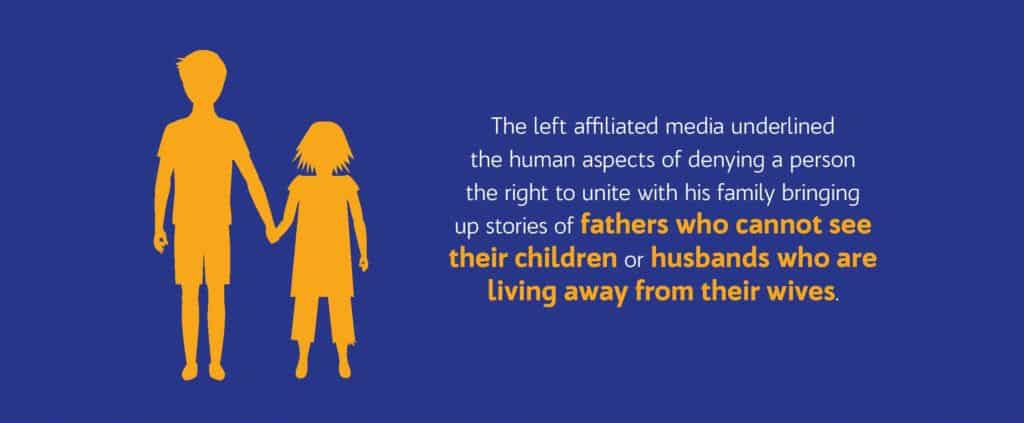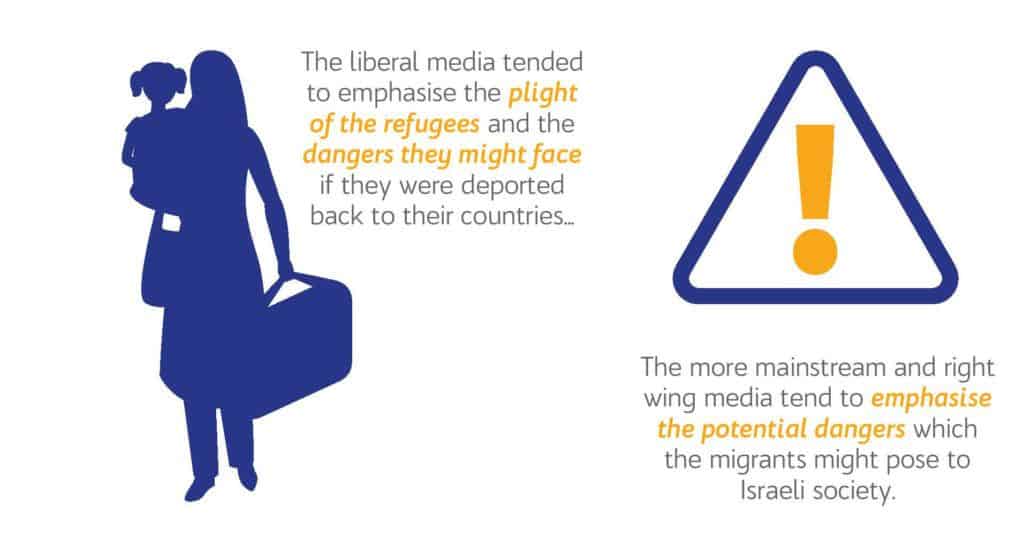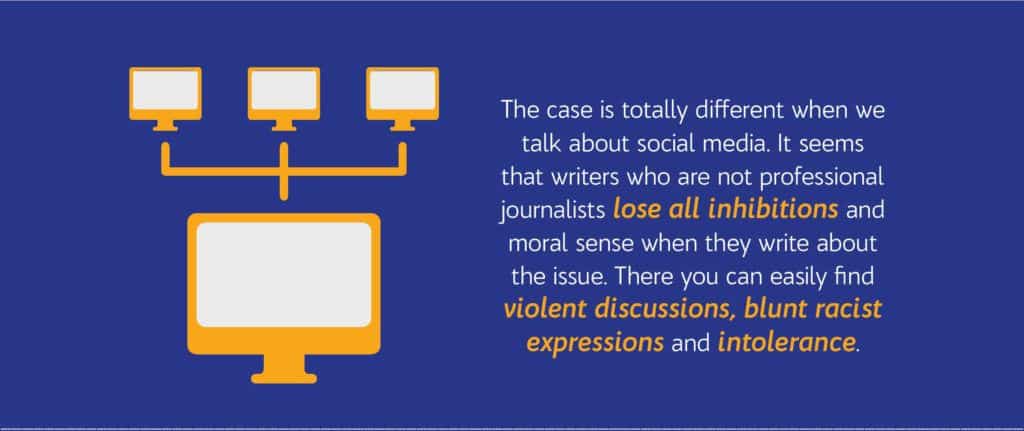This is a Chapter of the Study “How does the media on both sides of the Mediterranean report on migration?” carried out and prepared by the Ethical Journalism Network and commissioned in the framework of EUROMED Migration IV – a project, financed by the European Union and implemented by ICMPD. © European Union, 2017.
ISRAEL
Political Division and Internal Fears Drive the Migration Agenda
Shaike Komornik
Apart from brief interruptions, Jews have immigrated continuously into the originally Ottoman and later British-administered Palestine since 1882. Mass immigration characterised various periods of the 20th Century, especially the years before and after the founding of the state in 1948. The war that broke out with the neighbouring Arab states at this time led to the mass migration of Palestinian refugees and displaced persons. Later wars generated further refugee movements, with the result that today almost three quarters of Palestinians, around seven million, live outside their homeland.
The population of Israel has doubled several times over the decades as a result of immigration. Since 1948 more than three million immigrants have been registered. In the 1990s Israel had the highest percentage of immigration worldwide in proportion to the size of its population. Since the turn of the century Israel has been dealing with the immigration issue more intensively.
There are several approaches to dealing with this which are reflected in the Israeli political and social arenas and as a consequence in the mass media coverage. In order to fully understand these approaches we must first draw a picture of the current situation regarding the immigration issue in Israel.
The term “immigration” in Israel refers specifically to non-Jews who enter or wish to enter Israel for work purposes or to unite with their families. All Jews in the world are considered potential citizens and can enter Israel and become citizens on entrance, if they wish to, according to the “law of return” that was ratified after the birth of the state on 1948.
In Israel we refer to three main groups of immigrants:
Firstly, Palestinians from the West Bank or Gaza who wish to become Israeli citizens in order to unite with their families or to improve their living conditions. They could do it theoretically till 2012 by marrying an Israeli citizen, but that year the high court issued a ruling allowing the interior minister to refuse such requests on the basis that it can be used as a means of infiltration by hostile elements into Israel, with the underlying reason of a possible change in the demographic balance between Jews and Arabs in Israeli society.
This sort of immigration is now very rare and residence permits are given to very few. The media coverage of this kind of Palestinian immigration was, and still is, divided along political lines. The left affiliated media underlined the human aspects of denying a person the right to unite with his family bringing up stories of fathers who cannot see their children or husbands who are living away from their wives. The Left-wing newspaper Ha’aretz was the leader in framing this issue as an issue of humanity and not in terms of political and security considerations. However, most of the Israeli mainstream media regards this kind of immigration as a potential threat with expressions like the “fifth column” and an “enemy from within” used to describe the apparent threat. Cases of Palestinians who have used the family reunion pretext to enter Israel to commit terrorist acts have occupied the headlines and the front pages of the mainstream media when the debate was at its hottest, before the ruling of the High Court of Justice. The media interest in this sort of immigration has diminished since the court’s ruling and it seldom gets media attention which is usually reserved for cases involving Palestinians who moved to Israel before the restrictions and were accused of committing terror attacks. One can safely say that this kind of immigration has ceased to arouse media interest due to its small or virtually non-existent scale.
A second group of migrants are workers who come in large numbers from countries like The Philippines, Thailand, India and Nepal. They come to Israel with a work permit for 3 to 5 years working as carers for elderly or handicapped Israelis, or as agricultural workers. Most of these temporary workers return to their countries after the expiration of the work permit but quite a few of them choose to stay as illegal aliens to live and bring up their families in Israel. This group of immigrants does not draw too much media attention. They are usually accepted as hard working people who want to provide for their families. The main media coverage, which was dedicated to this group, was after the former Interior Minister, the head of the Shas religious party, Elie Yishay had decided in 2006 to launch an operation to expel these illegal immigrants from Israel and to toughen the criteria used to grant the children of these immigrants, who were born in Israel, citizenship.
These actions caused uproar within large sections of Israeli society and civil rights and civil society organisations who considered these steps a violation of human rights and an infringement of the rights of children who were born and raised in Israel and had no connections to the countries from which their parents came from.
The media, almost without exception, gave the fight of these children and their parents to gain citizenship very sympathetic coverage. Mainstream papers and radio and television networks ran with human interest stories of children and adolescents who were fully integrated in Israeli society and who were about to be deported to countries which are foreign to them. The media brought up stories which emphasised the emotional trauma of removing children from their homes and putting them on a plane to a strange country.
The only exceptions to this line of coverage could be found in the religious media, newspapers and radio stations (television and internet are forbidden to the ultra-orthodox Jews) which are concerned with the “danger” of inter-marriage with non-Jews and they are usually opposed to granting non-Jews permanent residence permits. The religious media strongly supported the Interior ministry’s policy of deporting these children and members of their families, but their views carry little weight in Israeli society as a whole.
The third group of immigrants, which caused and still causes a very hot debate within Israeli society, are illegal immigrants and refugees who have entered Israel in large numbers during the last 15 years from African countries via the Egyptian border. These immigrants used to cross the border and head straight to southern Tel- Aviv where they joined their fellow countrymen in establishing small colonies working in low-level jobs. If they were captured many would claim to be refugees from war torn countries like Sudan or Eritrea and were thus given a temporary permit to stay without officially recognising them as refugees.
According to data published by the immigration authority in October 2016 there are 37,000 asylum seekers from Eritrea and Sudan living in Israel now. Some 8,000 came from Darfur where a genocide has been taking place for more than 13 years. These figures were almost double those of a decade ago, before the government had taken steps to close the border with Egypt with an electric “smart” fence and by encouraging the Egyptian government to strengthen border controls. After this was achieved the Israeli government launched a plan to send these refugees back to their own countries or to a third country that was willing to accept them by giving them a sum of money as an incentive to leave of their own free will.
The government has refused or intentionally neglected to process the requests of these refugees to grant them permanent asylum. Of 18,000 such requests only about 2,000 were interviewed and only one person was given refugee status. The influx of African refugees or immigrants has caused a very sharp debate in Israeli society and has brought social and racial tensions to the surface, which has been reflected in the media coverage of the issue.
The residents of southern Tel-Aviv who are of a low socio-economic status to begin with, resented the settling of the African newcomers in their neighbourhoods. Violence and demonstrations have erupted and the tensions between groups of different social and economic status intensified. Some politicians took advantage of the situation, even going as far as using blunt racist language, accusing the refugees of spreading diseases and calling them a cancer within society.
The government has tried to deal with the issue in several ways. First, it tried to arrest as many of the migrants as possible and incarcerate them in a special detention camp in the Negev area. This decision was challenged in the high court by human rights activists and the court has allowed the government to build the camp but ordered that the residents remain free to go out and work in the daytime. It also put a limit on the time that a refugee can be detained there to three years.


The Israeli media coverage of this immigration and refugee problem has shown sharply different approaches. The liberal media, such as Ha’aretz newspaper and channel 10 TV and the public radio and TV, tended to emphasise the plight of the refugees and the dangers they might face if they were deported back to their countries, in addition to mentioning the treaties that Israel has signed and must adhere to on the issue of the refugees.
Another point which the liberal press stresses is the moral commitment of the Jewish people to help other peoples in distress, mentioning the cold shoulder the Jews received when they were persecuted and exterminated during World War 2. This media approach tries to tell both sides of the story. It is committed to telling the story of the migrants and that of the communities who suffer the burden of the influx of another poor and wretched group of people into their neighbourhoods. The framing with which this media has chosen to deal with this dilemma is to criticise the government for its inept handling of the problem.
The more mainstream and right wing media, on the other hand, tend to emphasise the potential dangers which the migrants might pose to Israeli society. They tend to stress the fact that many of these immigrants are Muslims and that they could constitute a security problem in the future. Newspapers like Maariv, Israel Hayom and TV channels like TV20 and religious Radio channels stress the danger that the migrants constitute by raising issues of high crime rate and inter-marriage. These media tend to press the government to take firm action to minimise the numbers of African immigrants. These pressures pushed the government to take the steps mentioned above to stop the immigrants arriving and deport large number of those who live here.
Another aspect of the immigration and refugee issue that has captured the interest of the Israeli media is the situation in Europe and the great flows of refugees from Syria and Iraq to the European continent. The overall approach of the mainstream Israeli media to this issue can be summed up in two framings.
The first is bringing up the plight of the refugees with human and sensational stories. This narrative arose mainly when the crisis was at its peak in 2015, when the main papers and TV stations sent correspondents and reporters to the main crisis locations and covered the human stories extensively. As the human crisis began to lose its momentum the narrative began to change, emphasising the potential danger that these refugees, the vast majority of whom are Muslims, can pose to European countries and to the European culture.
The big TV networks (channel 2 and channel 10) broadcast special reports on the growing Muslim population in Europe and the radicalisation of young Muslims born and raised in the continent. The attitude of some of the mainstream media was that Europeans, having had a taste of “what we have been facing for decades”, might “now change their attitude towards Islam and stop criticising Israel.”
As to the role that Israel should take vis-à-vis the Syrian refugee problem most prominent Israeli columnists and public opinion makers, while acknowledging the suffering of the refugees, advised the government not to enter the Syrian quagmire, for two main reasons: firstly, on the basis that Israel given its internal situation should not absorb more Muslims, some of them very radical; and, second, that Israel should in its own interests keep out of the Syrian conflict. The more liberal media, mainly Ha’aretz newspaper, took a different approach encouraging the government to accept a limited number of refugees from Aleppo, but this was the exception. There were other voices, such as the head of the labour opposition Yitzhak Herzog, who called upon the government to take this kind of action, but they were disregarded, and the issue has failed so far to stir up a debate in the mainstream media.
While the mainstream media is stressing the interests of the locals as opposed to those of the migrants, and emphasizing the potential dangers of migration, it does not use racist, inflammatory or derogatory terms. It does so only when quoting politicians or anti-immigration activists who try to stir up emotions.
Put simply, the migration coverage of the Israeli media tends to split along political lines. The left wing and liberal media, which has shrunk very much in the last few decades, is more inclined to stress the broad human rights issues, social injustice and the moral obligations to give the destitute a helping hand. It uses human interest stories to foster sympathy for the migrants, making more use of the terms “refugee” “asylum” “human rights” than the mainstream media. These media are more likely to call upon the government to grant migrants civil rights and citizenship and to give them more opportunities to speak and to present their case to the Israeli public.
Mainstream media, however, are more likely to give priority to informing the public about the state’s interests as they perceive it and to emphasise the side of the Israelis who are more vulnerable and prone to hardship as a consequence of newcomers moving into their neighbourhoods.
These media are also concerned with the human aspects of the immigrants and refugee issues but they do not try necessarily to achieve a change of attitude or to influence the public but rather to gain more readers or ratings by appealing on an emotional level.
While the mainstream media is stressing the interests of the locals as opposed to those of the migrants, and emphasizing the potential dangers of migration, it does not use racist, inflammatory or derogatory terms. It does so only when quoting politicians or anti-immigration activists who try to stir up emotions.
The case is totally different when we talk about social media. It seems that writers who are not professional journalists lose all inhibitions and moral sense when they write about the issue. There you can easily find violent discussions, blunt racist expressions and intolerance.
The Press Council in Israel has put a good deal of effort into curbing these violent discussions but unfortunately it does not have any effect on social media. It has brought several cases to the ethical tribunals but it has no jurisdiction over social media there. The situation in the social media has driven the government to start preparing a law to force social network sites to remove any inciting or racist posts immediately upon the authorities’ request.


The Press Council opposes this bill on the ground believing that it might constitute a slippery slope and have a negative effect on free speech. It prefers to find less intrusive means to curb the phenomenon. In conclusion we can say that the internal immigration issue has ceased to occupy much of the press attention in the last few years, since the scale of the problem has been diminished with the erection of the fence on the southern borders. On the whole the Israeli mainstream media has dealt fairly with the issue, but it should try to detach itself from the subjective point of view and give the migrants more voice and opportunities to have their say. The more ideologically committed press should also try give its audience more balanced reporting, but there is not much ground for optimism in this case. On the whole, the mainstream press should pay more attention to the refugee and migration issue beyond Israel’s borders. There should be more intensive and in-depth reporting of this complex issue rather than only reporting on the sensational cases where the human tragedy is at its peak. This is an issue for constant review and the media would do well to make it a more regular feature on the news agenda.
Shaike Komornik is a senior news editor in Israeli Public Radio in Arabic and chief editor of the digital section of the Israeli Broadcast Authority in Arabic.